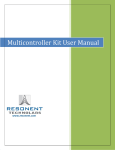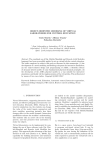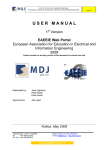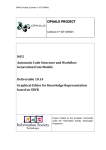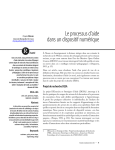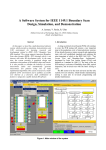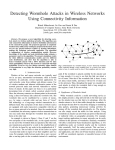Download remote programming for industrial automation
Transcript
Indian Streams Research Journal ORIGINAL ARTICLE ISSN:-2230-7850 REMOTE PROGRAMMING FOR INDUSTRIAL AUTOMATION Ritesh T. Palimkar and U. L. Bombale Mtech Student, Electronics Engineering, Department of Technology, Shivaji University, Maharashtra, India. Associate Professor, Electronics Engineering, Department of Technology, Shivaji University, Maharashtra, India. Abstract:The modernization in electronics and Embedded systems has made dramatic change in world. This systems are broadly used in automation, data monitoring, process control, remote jumbo display, etc. These products are manufactured by various companies. These companies have installed their products at various location as per their client's necessity. Controller based application products are manufactured by particular manufacturer and installed its clients company, which may be anywhere in the world. There is a serious problem when these manufacturers have to change the software of the microcontroller based product at remote location site, then support team of product manufacturer need to send one man to that location for changing the program. We have developed a system which have the program downloading facility from remote location for serially programmable microcontrollers. This system will be kept at that location. This system is connected to Internet and HEX file of controller will be changed in remote application unit. Keywords:Rabbit 3000 Micro Controller, Max 232, 16X2 LCD, Power Supply, Application unit using ARM7 or 89V51RD2 Micro Controller, MCP2551 CAN controller, MCP2550 Transceiver, Internet Connection with router and modem etc. www.isrj.net REMOTE PROGRAMMING FOR INDUSTRIAL AUTOMATION INTRODUCTION Remote Automation Programming (also known as online Automation Programming, remote workbench) uses telecommunication system to remotely conduct automation programming, at the physical location of the automation application. Remote Automation Programming allows users to perform tasks or change the task of the automated equipment by changing its programming, over the Internet without being near to the actual equipment. This facility provides an environment for remote users to do many automation tasks while using different controllers together with several types of sensors, actuators and industrial communication networks. The physical architecture of remote automation programming is designed for an easy and convenient up gradation, which converts automated equipment into a highly flexible and versatile tool which is able to do the required work. With the help of this remote automation programming technique we are able to upgrade system and able to remove the bugs from the automated equipment for the improvements in the automated system. Here, remote automation programming system uses the networking part which is the interface between internet and the automation equipment Remote automation programming system consists of the client which produces the hex file of the program which we want to burn on the application. Remote user is connected to Rabbit processer unit through internet. Rabbit processer unit is connected to the automation application. VB program is used to access processer unit which is connected to the automation application. This VB program gives the information about the automation application. Automation programming codes is written in programming tool, which on compilation generates hex file. Hex file is generated for desired automation application. Hex file generated is first tested for the desired application. VB program has the option for resetting automation application which is required for burning hex file on target application. On resetting application unit hex file is send on the internet. Hex file will be received at processor unit. PROPOSED SYSTEM In the proposed system, first of all the requirement of application is considered. And as per the required task program codes is changed. Program codes will be written for required task in programming tool at client pc. The hex file generated after compilation it will be tested for required application. After testing it for required task hex file will send through the internet. Clint at remote location access the rabbit processer controlling assembly throw VB program with the use of VB program application. On the VB program there will be interface for controlling application controller for burning codes on it. The options will be program mode and reset mode. Indian Streams Research Journal | Volume 4 | Issue 5 | June 2014 2 REMOTE PROGRAMMING FOR INDUSTRIAL AUTOMATION 1.CLIENT UNIT In this system programmer will writing a program codes for automation application. Generated hex file will be sent on internet through Visual Basics. Programmer will communicate through VB program with help of rabbit processer assembly IP address. VB program will have options for controlling automation application. 2.CONTROLLING UNIT In this system rabbit processer assembly used to perform all the tasks. The Rabbit controllers are having several powerful design features. Rabbit controllers are very robust to EMI emission form industries and regulatory radiofrequency emissions tests. The Rabbit is having low electromagnetic interference (EMI), again it have a high-performance microprocessor and is designed specifically for embedded systems, control system, networking and communications [6]. It is used for networking. It acts as gateway between application and internet. Client at remote location do programming of desired task and generate hex file. Then through internet client gets connected to controlling assembly through networking and send hex file to it. Hex file received at controlling unit is ready to burn on the automation application. Hex file received is loaded in to application serially. Controlling circuitry will interfaced with Rabbit processer assembly. Controlling circuitry controls operation of program mode/reset mode for burning program on application.. 3.AUTOMATION APPLICATION UNIT Third part will be automation application part. Application will be interfaced with rabbit processer assembly. Controlling circuitry also interfaced with rabbit processer for controlling operation of serially loading program in to the application. Automation application will communicate with rabbit processer through MAX232 logic converter HARDWARE IMPLEMENTATION Rabbit Processor based controlling board, this controlling board acts as the interface between the controllers based automation machine and the internet. Rabbit module used have specifications,The Rabbit 3000 which work at frequency of 55.5 MHz, it supports Compact code and it size may be upto 6 MB. Operating voltages of the rabbit controller is a 1.8 V to 3.6 V, Faster response to real-time embedded application is due to Four levels of interrupt priority. CAN communication is used in application unit in between 89v51 microcontroller and PIC 16F87x. CAN controller and CAN transreciver is used for the DATA transfer. MAX232 is for the logic level converter. Figure2. Hardware Required For The Proposed System Indian Streams Research Journal | Volume 4 | Issue 5 | June 2014 3 REMOTE PROGRAMMING FOR INDUSTRIAL AUTOMATION SOFTWARE IMPLEMENTATION Keil v3 is used for the programming of the controller, To write code for the Rabbit controller Dynamic C is used. VB programming is done for developing the Windows application. For the loading the program in microcontroller we required program loader, here we use flash magic software for the system which is at remote location. The windows socket programming (WINSOC) is required to send the data generated by the program loader. The data generated by the program loader is not in to TCP/IP format, by the use of WINSOC data can be sent on TCP/IP network. With the help of IP address technician gets connected to the Rabbit Processor Based controlling board. Figure 3:- VB based Windows application on remote PC RESULTS The parameters such as level and temperature can be observed in VB based windows application program at remote PC. Figure4:- Different parameters observed at remote location. After completion of the HEX file loading process the Display which is present at the site where actual application is present. Indian Streams Research Journal | Volume 4 | Issue 5 | June 2014 4 REMOTE PROGRAMMING FOR INDUSTRIAL AUTOMATION Figure8:- Result shown on display after completion of HEX file loading FUTURE SCOPE In the future scope of this system we can introduce addition of the work which can find the bugs in the microcontroller based application software and change only that part of the code. In the future scope we have to work on the time delay. This Time delay is when we have sent the file from remote location to the actually time that, program gets changed in the microcontroller based application. We have to work on the system to form real time systems which can be used for the faster operation to change the large programme file of the real time application. CONCLUSION Required parameters can be observed on remote PC with the help of VB windows application. Time required to download the 16k HEX file in the microcontroller is 3 min 27sec when the net speed is 512kbps. with the help of increase in internet speed from 512kbps to 3mbps, time required to load HEX file can be reduced REFERENCE 1.Alfredo Gardel Vicente, Ignacio Bravo Munoz, Member, IEEE, Jose Luis Lazaro Galilea, and Pedro A. Revenga del Toro, “Remote Automation Laboratory Using a Cluster of Virtual Machines,” IEEE Transactions On Industrial Electronics, Vol. 57, No. 10, October2010 2.R. Dormido, H. Vargas, N. Duro, J. Sanchez, S. Dormido-Canto, G. Farias,F. Esquembre, and S. Dormido, “Development of a Web-based control laboratory for automation technicians: The three-tank system,” IEEE Trans. Educ., vol. 51, no. 1, pp. 35–44, Feb. 2008. 3.P. Coquar, M. Guillemot, D. Noterman, A. Leleve, and H. Benmohamed, “Remote laboratories: AIPPrimeca RAO platform,” in Proc. 2nd ICDIM, 2007, vol. 2, pp. 762–767. 4.H. Hassan, C. Dominguez, J. M. Martinez, A. Perles, and J. Albaladejo, “Remote laboratory architecture for the validation of industrial control applications,”IEEE Trans. Ind. Electron., vol. 54, no. 6, pp. 3094–3102, Dec. 2007 5.Luis Gomes, Senior Member, IEEE, and Seta Bogosyan, Senior Member, IEEE, “Current Trends in Remote Laboratories,” IEEE Transactions On Industrial Electronics, Vol. 56, No. 12, December2009 6.Rabbit 3000 Microprocessor User's Manual. 7.R. Marques, J. Rocha, S. Rafael, and J. F. Martins, “Design and implementation of a reconfigurable remote laboratory, using oscilloscope/PLC network for WWW access,” IEEE Trans. Ind. Electron., vol. 55, no. 6, pp. 2425–2432, Jun. 2008 8.J. Ligus, J. Ligusova, and I. Zolotova, “Distributed remote laboratories in automation education,” in Proc. 16th EAEEIE Annu. Conf. Innov. Educ. Elect. Inf. Eng., 2005, ID: 56, pp. 1–6 9.C. Lazar and S. Carari, “A remote-control engineering laboratory,”IEEE Trans. Ind. Electron., vol. 55, no. 6, pp. 2368–2375, Jun. 2008 10.M. Martínez and J. V. Salcedo, “ProPID: An interactive CAD tool for control education,”Int. J. Eng. Educ., vol. 24, no. 4, pp. 1191–1198, Dec. 2008 11.H. Soumare, R. Shroff, J. L. Hardison, J. A. del Alamo, V. Judson Harvard, P. H. Bailey, and K. K. Delong, “A versatile Internet-accessible electronics workbench with troubleshooting capabilities,”Int. J. Online Eng. (iJOE), vol. 5, no. SI1, pp. 72–80, 2009. Indian Streams Research Journal | Volume 4 | Issue 5 | June 2014 5





